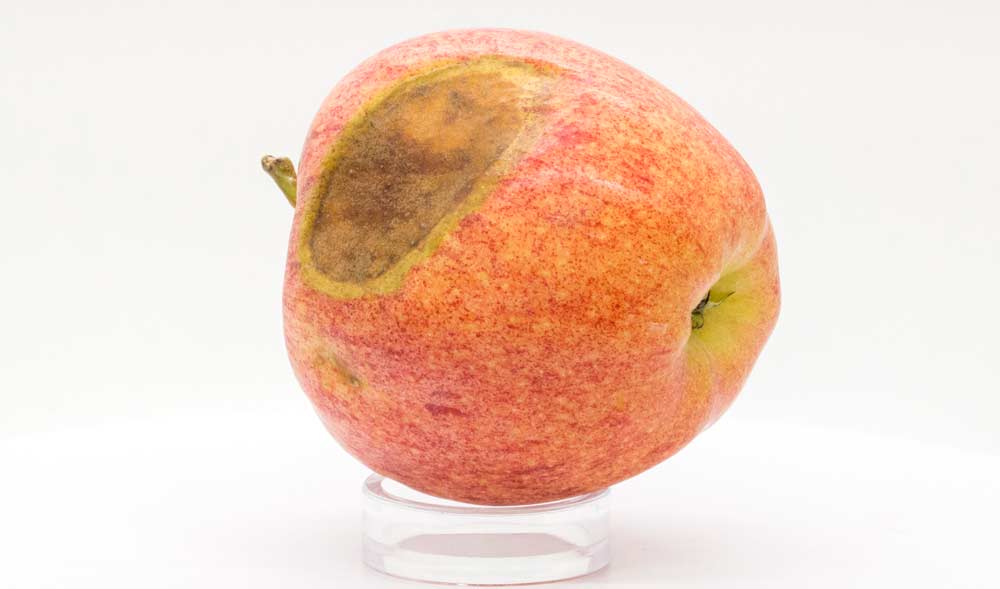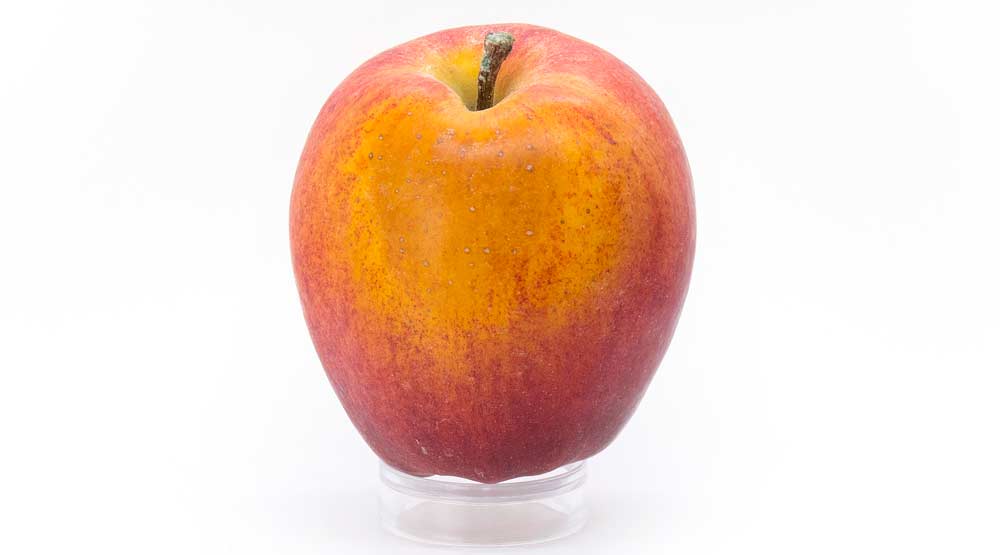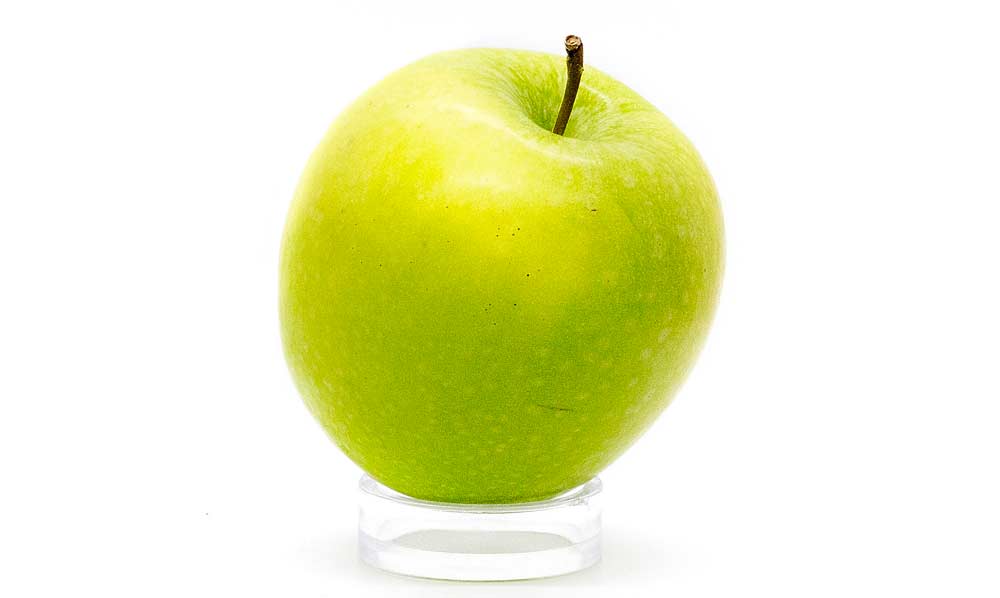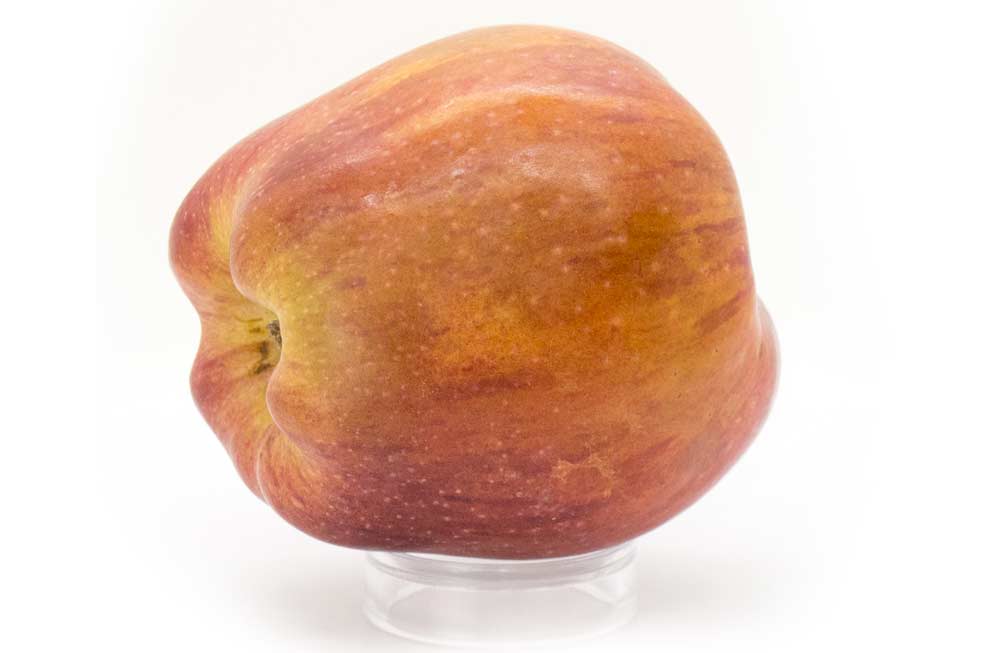In sun-soaked growing regions, such as Central Washington or Chile, the sun’s damaging rays pose a risk of sunburn and delayed sunscald in apples.
The damage is driven by exposure to high light and hot weather, so researchers are working to develop tools to detect crop stress and exposure levels to help growers predict and prevent damage.
While sunburn shows itself in the field, delayed sunburn, also known as sunscald, appears after storage and poses a particularly difficult problem for growers because it cuts packout rates seemingly without warning.
Chilean researchers aim to fix the problem by identifying the subtle warning signs in sun-exposed apples, so that growers can take steps to prevent damage in the first place and so fruit that’s likely to develop damage in storage can be sold quickly.
The sunscald problem is “fruit that looks healthy, it looks fine when it goes into storage, but then it will develop this surface browning,” said Carolina Torres, a professor of horticulture at the Universdad de Talca in Chile.
She spoke to Washington growers at a field day in Quincy in May. “So we’re trying to predict its appearance, and we know that the more sunburn we see pre-harvest, the more sunscald we will have after 30 days in cold storage.”
And there is no postharvest control for sunscald. That’s why Torres says it’s important to break through the typical separation between postharvest practices and orchard management to address this disorder, which is estimated to cost about $100 million in losses every year in both Washington state and in Chile.
“This is a postharvest problem, but we need to work to correct it in the field. We know conditions in the field where fruit was produced will directly affect how fruit will do postharvest.” Torres said. “We have a very bad climate for sunburn in Grannies in Chile, and with climate change, it’s getting worse.”
Predicting damage
Since immediately visible and delayed sun damage are driven by the same light and heat exposure, Torres and her colleagues deduced that they could use the rate of sunburn present on a lot of fruit at harvest to predict how the rest of the fruit will perform in storage.
Using the model is relatively simple: Take a sample batch of 100 apples and classify the level of sun exposure as shaded, exposed, mild sunburn, moderate sunburn and severe sunburn.
The model uses that data to predict how much delayed damage will develop with each subsequent week in storage.
“You can think about what batches were more susceptible and sell those earlier,” Torres said.
The model is being tested for commercial use in Chile now, she said, and a similar model is in development in Washington by U.S. Department of Agriculture research physiologist David Rudell, which will rely on sun damage data collected in the state.
Of course, that strategy doesn’t help growers prevent worsening damage in the first place. Torres is also working on two tools that could help growers “see” the heat and light stress on apples in real time.
One tool uses infrared imaging to calculate a crop water stress index, based on the temperature of the fruit. In her studies on Granny Smith apples, crop water stress index can successfully predict sun damage more than a month before the browning occurs on the fruit.
“We found that fruit with severe or moderate sunburn was stressed prior to showing symptoms. It was normal to the eyes, but it was suffering,” Torres said. She added that her findings should be relatively easy to commercialize into a tool growers can use, perhaps in the form of an app that analyzes the thermal images. “You only need an infrared thermometer camera to take pictures in the field and to translate that into this index to see how prone the fruit is to develop severe sunburn symptoms.”
And the fruit responds to that stress with biochemical changes in the peel, including increasing levels of compounds called flavonoids, which serve a sunblock-like defense function.
Those chemical changes can also be detected by a device called a spectrometer, which measures precise wavelengths of light reflected from the surface of the fruit. Different peel composition with higher levels of flavonoids means a different light reflection.
“The exposed side is a completely different beast, physiologically and biochemically, which is amazing because it’s the same apple,” Torres said. “The cool thing about reflectance is the tool is nondestructive, and the machines are very portable now.”
Her initial experiments demonstrate that reflectance data can be used in the orchards and in postharvest analysis to predict which fruit will go on to develop sunscald.
But, processing the data that result from a spectrometer is not realistic for growers, Torres said.
For this approach to work on a commercial scale, someone would have to create a specialized device to look for the key sun damage signals, similar to how the DA meter analyzes the light reflection signature of fruit chlorophyll to provide information about ripening stage.
That’s down the road, but Torres said it’s an exciting time to be testing these technologies that can hopefully expand the ability of growers and packers to predict and prevent sun damage. •
Types of sun damage:
There are three types of primary sun damage and then several delayed disorders related to sun and heat overexposure. Here’s how Rob Blakey, a Washington State University tree fruit postharvest specialist, explained the difference.
Sunburn necrosis:

Sunburn necrosis. (TJ Mullinax/Good Fruit Grower, Washington State University, Washington State Tree Fruit Research Commission)
Occurs while the fruit is still on the tree and the surface temperature exceeds 125 degrees.
Temperatures that high can result in cell death in as little as 10 minutes, leading to a dark spot of “cooked” tissue on the sun-exposed side.
Sunburn browning:

Sun browning damage in Gala. (TJ Mullinax/Good Fruit Grower, Washington State University, Washington State Tree Fruit Research Commission)
The most common type of sun damage in Washington, sunburn browning occurs when there is high solar radiation and fruit surface temperatures above 115 degrees.
That can happen when air temperatures are at about 95 degrees. WSU’s decision aid system has a model to predict when orchards will be at risk for sunburn browning.
Photo-oxidative sunburn:

Photo-oxidative sunburn in Granny Smith apples. (TJ Mullinax/Good Fruit Grower, Washington State University, Washington State Tree Fruit Research Commission)
Occurs when light bleaches the pigment in the fruit’s peel during a sudden exposure to sunlight.
Summer pruning, position changes late in the season, or postharvest sun exposure can lead to the damage. The damaged area initially looks whitened, but browning will follow in more severe cases.
Delayed sunburn or sunscald:

Delayed sunburn browning on Red Delicious apples. (TJ Mullinax/Good Fruit Grower, Washington State University, Washington State Tree Fruit Research Commission)
Fruit that looks fine can develop skin browning symptoms from sun and heat damage after months in storage.
– by Kate Prengaman






Leave A Comment